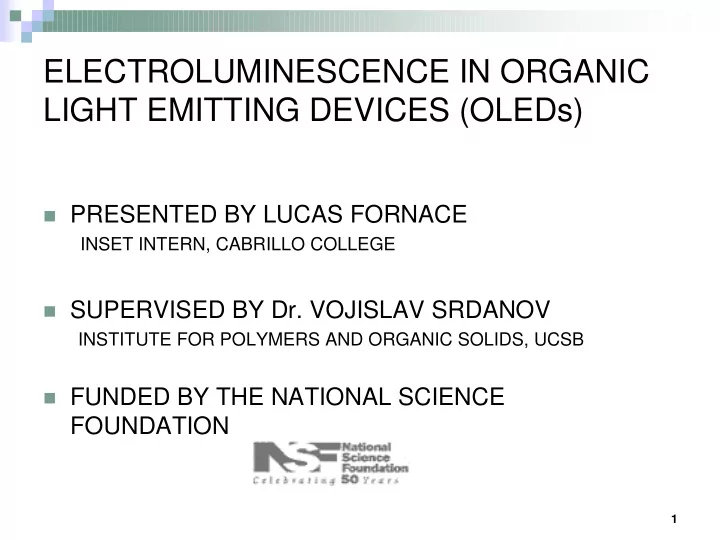

ELECTROLUMINESCENCE IN ORGANIC LIGHT EMITTING DEVICES (OLEDs) ! PRESENTED BY LUCAS FORNACE INSET INTERN, CABRILLO COLLEGE ! SUPERVISED BY Dr. VOJISLAV SRDANOV INSTITUTE FOR POLYMERS AND ORGANIC SOLIDS, UCSB ! FUNDED BY THE NATIONAL SCIENCE FOUNDATION 1
ORGANIC LIGHT EMITTING DIODES BY MOLECULAR BEAM EPITAXY Intern: Lucas Fornace, Cabrillo College Program: INSET Supervisor: Dr. Vojislav Srdanov Institute for Polymers and Organic Solids, UCSB The dream of using organic materials in high performance optoelectronic devices is rapidly becoming a reality. These include, but are not limited to, organic light emitting devices (OLEDs); photovoltaic cells; and photo detectors. Such organic devices have reached performance levels comparable to or, in some cases, even better than their inorganic counterparts. They are inexpensive, can be fabricated on flexible substrates, and can be easily modified with the addition of a large variety of chemical functional groups. My project was focused on the fabrication of organic light emitting diodes and Fullerene based photocells grown by molecular beam epitaxy. To this end we put together a high-vacuum chamber for thermal evaporation of organic compounds, which was optically coupled to a remote diode-array spectrophotometer. This allows for acquisition of absorption spectra during thin film deposition and thus provides immediate feedback regarding the film thickness and composition. Typical device geometry consists of a transparent, yet conductive, indium-tin-oxide substrate on which we deposit an active organic layer sandwiched between a hole-transport layer and an electron-transport layer. The active layer is a strongly luminescent organic material (in the case of OLEDs), or a strongly absorbing material (in the case of photocells). On top of this we deposit a thin aluminum electrode layer. The OLEDs would emit bright light when a small voltage is applied across it, while photocells produce a couple of volts when exposed to sunlight. Our research will aid in the optimization of these organic layers. Summer Research Colloquium Session 1 10:00 am August 15, 2002 Engineering II Pavilion Lucas Fornace, INSET Intern Cabrillo College/UC San Diego lfornace@hotmail.com 2
OLED STRUCTURE " THE DEVICE CONSISTS OF FIVE LAYERS ON A TRANSPARENT SUBSTRATE: THE FIRST IS AN INDIUM TIN OXIDE " (ITO) ANODE. ITO IS A TRANSPARENT, YET CONDUCTIVE MATERIAL. THE NEXT IS AN ORGANIC MATERIAL " WHICH ASSISTS IN THE TRANSPORT OF HOLES FROM THE ANODE. " THE CENTRAL LAYER IS AN EXTREMELY LUMINESCENT ORGANOMETALIC MATERIAL. THE FOURTH LAYER IS ANOTHER " ORGANIC MATERIAL THAT HELPS THE TRANSPORT OF ELECTRONS FROM THE CATHODE. " LASTLY, A LOW WORK FUNCTION METAL WILL ACT AS A CATHODE AND SUPPLY THE ELECTRONS. FROM AMERICAN DYE SOURCE, INC 3
OLED PHYSICS ! OPERATION OF OLEDs DEPENDS ON THE INJECTION OF HOLES FROM THE ANODE AND ELECTRONS FROM THE CATHODE, DRIVEN BY A VOLTAGE PRESSURE. RECOMBINATION OF THE PARTICLES IN THE ! EMISSIVE LAYER RELEASES AN EXCITON (PHOTON) UPON RELAXATION TO THE GROUND STATE. ! THE THREE ORGANIC LAYERS NEED TO BE SEPARATELY OPTIMIZED TO MAKE SURE THAT THIS RECOMBINATION TAKES PLACE IN THE EMISSIVE LAYER. THIS OPTIMIZATION INVOLVES STUDYING THE MATERIAL’S ENERGY TRANSPORT PROPERTIES AND HAVING PRECISE CONTROL OVER FILM FLEXIBLE OLED FROM DUPONT DISPLAYS THICKNESS. 4
EXAGGERATED THREE STEP FILM USING A MOVEABLE MASK TO BLOCK DEPOSITION, FILMS WITH THREE LEVELS OF THICKNESS WERE PREPARED. FROM THIS WE CAN GATHER ABSORPTION DATA AS WELL AS MECHANICAL THICKNESS AT FOUR POINTS, ENABLING US TO ASSIGN A LINEAR CORRELATION BETWEEN THE TWO. FURTHERMORE, THIS INFORMATION ALLOWS US TO MONITOR FILM THICKNESS AND, MORE IMPORTANTLY, BLENDED FILM COMPOSITION DURING DEPOSITION. 5
IN THE LAB FILMS ARE GROWN VIA HIGH VACUUM THERMAL EVAPORATION. SHOWN ! HERE IS A VIEW INTO THE CHAMBER FROM ABOVE, LOOKING THROUGH THE CRYSTAL SUBSTRATE. THE COPPER LEADS HOLD A TANTALUM BOAT LOADED WITH THE ORGANIC MATERIAL TO BE DEPOSITED. 6
EUROPIUM ADS051RE FILM B 0.32 24 min 22 min 0.28 20 min 0.24 18 min Absorbance 16 min 0.2 14 min 0.16 12 min 10 min 0.12 8 min 6 min 0.08 0.04 0 250 300 350 400 450 500 wavelength (nm) THE SUBSTRATE IS OPTICALLY COUPLED TO A REMOTE DIODE-ARRAY SPECTROPHOTOMETER, ALLOWING FOR ACQUISITION OF ABSORPTION SPECTRA DURING DEPOSITION, PROVIDING IMMEDIATE FEEDBACK OF FILM THICKNESS AND COMPOSITION. 7
ACKNOWLEDGEMENTS Dr. VOJISLAV I. SRDANOV AND FAMILY LJILJANA DAMJANOVIC INSET PROGRAM AND STAFF TERRY AND BRUCE, CHEMISTRY MACHINE SHOP PAUL FORSTER MARTIN VANDERBROEK, ENG 1 MRL AND STAFF UC SANTA BARBARA NATIONAL SCIENCE FOUNDATION 8
Recommend
More recommend